The history of the design levels Duke Nukem (with sketches of Levelrord)

On the eve of the 22nd anniversary of Duke Nukem yesterday we wrote about the history of the game . Today we will talk about the design levels of official releases of the main series of Duke Nukem games, not spin-offs, and especially not third-party modifications. The text here and there scattered quotes from our interview with the legendary Duke Nukem designer Richard Gray Levelord , which we took from him specifically for this post. If you notice inaccuracies or are sure that we missed something important - write about it in the comments and we will add information to the article.
Duke nukem
▍1991
Game Designers: Todd Riplogl, Scott Miller.
Artworks: George Broussard, Jim Norwood.
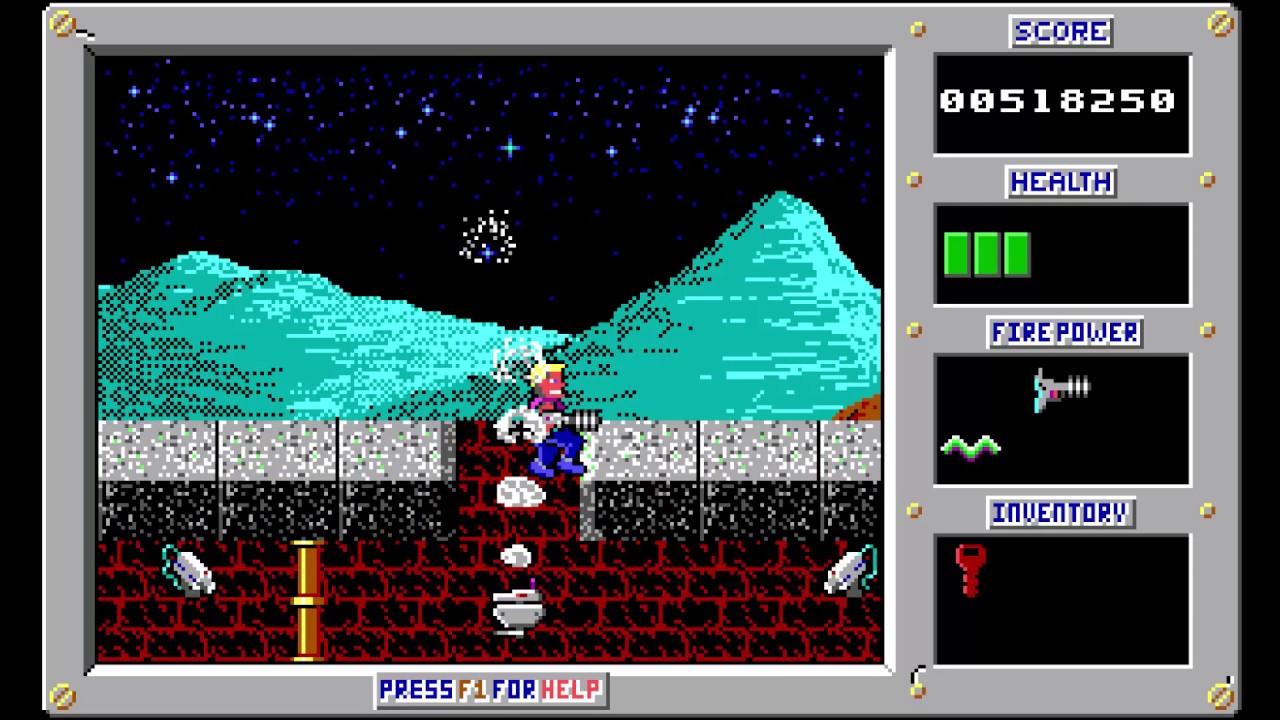
')
▍Pro game itself
Primitive two-dimensional arcade, platformer side scroller. The hero - Duke Nyukem (Nuclear Duke), brutal jock in a pink t-shirt - is literally a handful of pixels. His main tasks: run up the stairs and jump on platforms, killing monsters and collecting items that allow you to get closer to the next level.
Levelaord: “The character of the duke is right in front of you: stupid, and he does not apologize for offending someone. It was created for young people, who then accounted for 99% of the players, but I think that it is still funny today. He had a wry sense of humor that a tough hero should have, like heroes in most action movies. He also mocked these popular characters, repeating their famous expressions. ”
At the end of each level (with the exception of the last level in each episode), a player can receive up to seven ten-thousandth bonus points earned for certain achievements at the level:
- Destroy all security cameras at level

- Do not lose health level
- Drop All ACME Signs

- Destroy all missiles at level
- Collect all the letters D, U, K and E in the correct order
- Destruction of all technobo snakes
- The destruction of all rabbits technobots

In the game there are a lot of bonuses in general: improvements for weapons, allowing to increase the speed of shooting; winged boots that make duke jump higher; claw, allowing to cling to certain ceilings. There are still many items to collect that simply offer glasses - for example, floppy disks, flags, radio and balloons. In addition to points, some collectibles include health bonuses. Most pickups can be found inside the color boxes that open when fired. However, some gray boxes are traps and detect dynamite, which explodes and may cause damage to Duke. With each level, the enemies are becoming more dangerous.
▍Pro weapons
In this game, Duke Nukem uses only one weapon: an atomic gun that shoots large green zigzag nuclear shots. They can only shoot straight (i.e., left or right), not up or down. An atomic gun can be improved by selecting a special improvement item that looks like the atomic gun itself. Each time an update starts, an additional nuclear bolt icon is displayed in the items panel on the right. This indicates the number of nuclear bolts that may appear on the screen at the same time. The highest upgrade level is 5.
▍Pro design
Movement is possible only to the side. Graphics based on scrolling. The player observes the process as if through a virtual camera located on the side of the scene. Due to technical limitations, the game world is scrolled by an offset of 8x8 "blocks", rather than individual pixels. Console and arcade games, as a rule, would do this using special equipment, such as NES PPU , which can scroll through the background. Graphics borrowed from other games such as Turrican and Mega Man (PC version).
At one time, the game became popular, among other things, thanks to its clever level design, which makes the gameplay very fast. There are several routes that a player can take at each level and they all end at the same place. In addition, there was much to learn. This combination really enjoyed the nineties gamers.
Duke Nukem II
▍1993
Game Designers: Todd Riplogl, George Broussard, Scott Miller
Writer: Tom Hall

▍Pro game itself
Like the first part, this is also a two-dimensional side-scroller. But there are many new features and more interactivity (which will later become the main feature of Duke Nukem). Nyukem runs most of the game on foot, but on some levels it is inside the car. The game is divided into four episodes (without titles), each of which consists of 8 levels (without titles).
▍Pro weapons
Weapons 4 types, it is in the green boxes and looks like round coins with letters (one of the four): a short red explosion, a flamethrower, a large blue laser, Rocket Launcher. Weapons and ammunition are transferred to the next level. More bonuses in different color drawers.
▍Pro design
The game is very similar to the original, but with improved graphics. Inclined surfaces appeared, the hero can now shoot up and down, crouch, hang on objects.
Duke nukem 3d
▍1996
Game Designers: Todd Riplogl, George Broussard.
Level designers: Allen Bloom III, Richard Gray (Levelord), Randall Pitchford II, Keith Schuler, George Broussard.

▍Pro game itself
Now this is a “three-dimensional” first-person shooter (about why the word “three-dimensional” is quoted - below). The game has five episodes with a different number of levels. Duke Nukem 3D was the first commercial implementation of the new powerful Build graphics engine developed by Ken Silverman. Technically, Build complied with and in some cases exceeded the Doom engine and other games that were before. The game has become a real hit and legend due to the unprecedented approach to level design. Unlike Doom and RotT, levels in Duke 3D were usually built around a central theme, and also shared a thematic link through the episode. For example, many of the levels in the first and third episodes are focused on recognizable urban buildings, such as a cinema, a sushi house, a prison, and so on. The second episode consists of more bizarre, but still recognizable cosmic structures. Again, all of these cards, while not linear in the sense that they are related, for example, in Half-Life, are still related, giving the player the impression of a larger world. The fact that the gaming world was easily recognizable and more interactive than ever made Duke Nukem 3D extremely popular.
Scenario principle of transitions from level to level consider the example of the first episode - LA Meltdown:
In the course of the action, the hero finds himself in different situations and different locations, which become the next levels. The action takes place in Los Angeles, where the hero gets from his downed alien ship. He sneaks through the deserted streets, the cinema (level 1, later in the text the designation is simply a digit), “Red Light District” (2) and into a strip bar falls into the trap of the aliens. He is taken prisoner, then sent to prison (3) for execution in the electric chair. He escapes from there, finds a submarine, after the crash of which he ends up at a toxic waste processing plant (4). After that, he gets into the gorge (5), next to which he found a flying saucer, in which he finds and kills the final boss of this episode.
- Hollywood holocaust
- Red Light District
- Death row
- Toxic Dump (there is a secret exit to level 6)
- The Abyss (there is a secret exit to level 7)
- Launch Facility (secret level)
- Faces of death
- Dukematch Level 1

Pro innovations at levels
Now the game allowed the player to fully view the space with a mouse with its characteristic distortion when the cursor is moved away from the center. Vertical movements have become possible. Multiplayer appeared. The color scheme was improved and began to add the game atmosphere. Monsters have become more diverse. There is a large selection of weapons, each of which can be worn fully charged. There were interesting " Easter eggs ". The hero has also changed: now he wears glasses, does not wear a pink jersey, smokes roll-up cigars and jokes with sparks at every step (he even quarrels with the player).

The main attractive feature of the game was the variable level architecture in the editor that came with the game. Duke Nukem 3D levels bring the player outside through the rendering of street scenes, military bases, deserts, flooded cities, space stations, and lunar bases. Many of the levels have a rather non-linear design that allows players to carefully examine these levels in various ways and allows them to discover many secret areas. The non-linearity of levels also makes it easy to use them in multiplayer games — you can literally create your own level. There was an opportunity to create pseudo-room-over-room (a room above the room) - sectors different in height, not separated by anything, in which “you” and “enemies” are inaccessible to each other, although you can hear each other’s shots (portal-sector technology which allowed to create different rooms in one geometric space).

Buttons and levers can be placed not only on the walls, but also on the floor and on the ceiling; You can turn them on or off. You can look at the "real" surveillance cameras and mirrors; You can perform various actions with the toilet (not only classic) - a joke that has become a textbook among initiates; to level the blood on the shoes and so on. Detailing (for example, bullet traces) and high interactivity of interaction with the environment in the game (the ability to play billiards; transportation; girls exposed, if given several coins and the like) have become unprecedented. Such interactivity literally became revolutionary in the gaming industry. However, it is worth noting that this was not really a dynamic change in parts of a level — only its illusion was created with the help of certain effects used by designers in the level design program. Such methods gave the player the illusion that they strongly influence or change the playing space, whereas in reality they simply trigger special effects.
▍Pro weapons
Levelord: “Duke Nukem 3D had very original weapons and gadgets, even by today's standards. For example, Shrinker - what a cool weapon! (Allowed to reduce the enemy, then to trample him. Especially delivered with a multiplayer game). The diminution was fun, but it was most amusing to step on a mini monster. It was not only a weapon against the bad guys. We figured out how Duke could use Shrinker on himself to get into small places. We added a Shrinker blast to the source in the Abyss, which was to be used to complete the level. This is what made me think of that famous Easter eggs “You should not be here!”
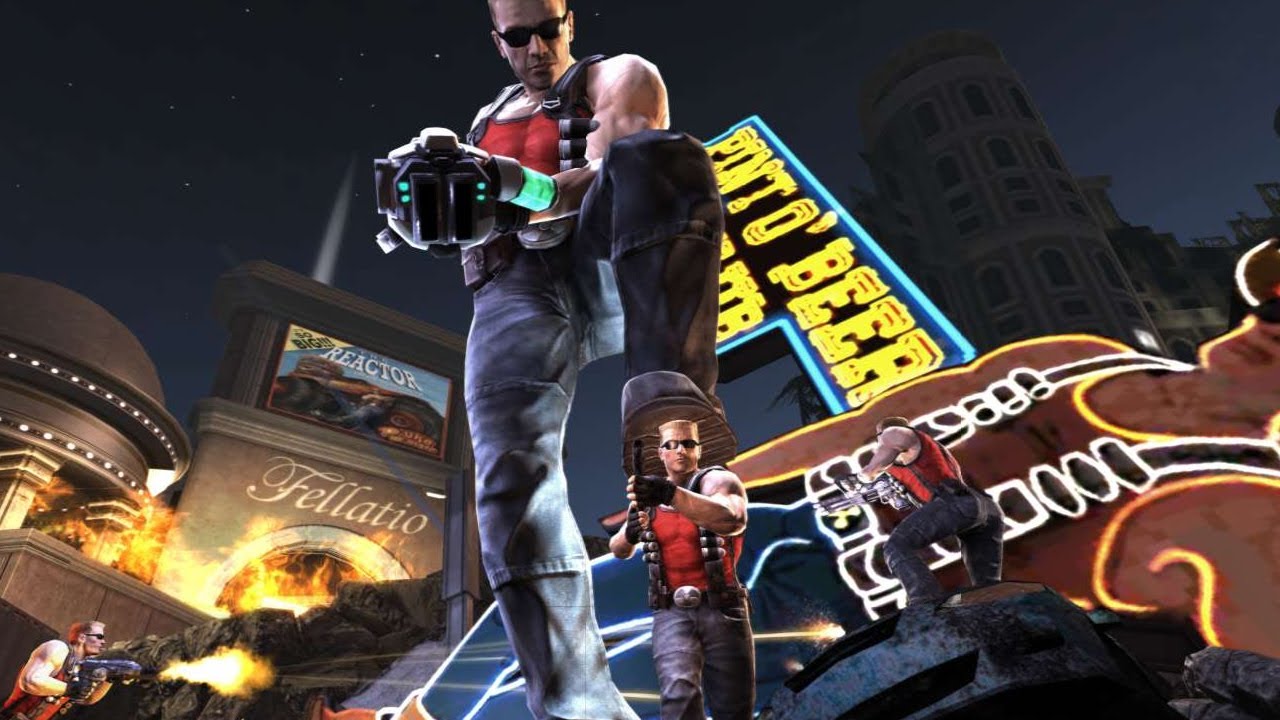
Trip Mines were another unprecedented weapon. They were very funny for both single player and multiplayer maps. Like Shrinker, Allen and I made the player use them to solve puzzles. Ha! I just remember putting them next to the teleporters at Deadly Death :). Another innovation was that the bombs in the pipe could be thrown into the rooms and fully control the moment of the explosion. Pipe bombs in elevators! I remember using Trip Mines as a little riddle at Incubator level. The player will find an exit to the elevator, blocked by a set of Trip Mines. The puzzle was for the player to understand that placing a tube bomb in the elevator and sending it down to turn off the mines was the only solution.
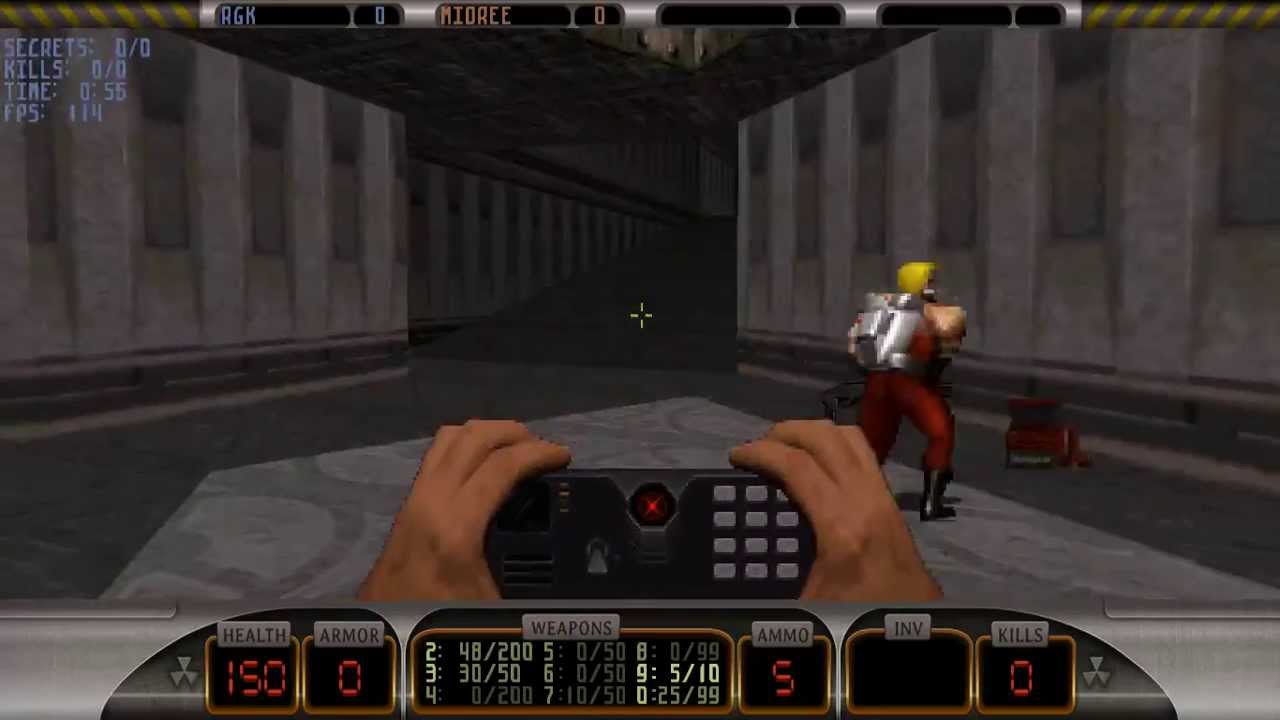
Jet Pack was also good both in a single game and in a “deadly match”. The game was fun, but I have to tell you that it was a lot of trouble for us, the developers of the levels, who had to make sure that the players would be able to reach the areas before we take the critical path. It was Jet Pack that spawned the idea of posting this hidden message "You should not be here" in the Abyss.
One final note: remember that Duke had to compete with DOOM, which was still very popular. Even more incredible is that he had to compete with Quake - the first truly 3D shooter! Both were released in the first half of 1996. I was lucky that I was able to work on Duke Nukem 3D. We had a great team that worked together synergistically and creatively, which I haven’t seen since then. Hail to the King, baby! ”
▍Pro design
Duke 3D, despite all its technical innovations, was not a completely three-dimensional world. Enemies were still based on sprites, like all in-game objects. But the game has many innovative applications for sprites, allowing you to apply certain decorative sprites directly on the surface of the walls. These sprites were commonly used for items such as signboards, boards, and calendars, although they were also used to splash blood on walls, cracks, burn marks, and bullet holes. These sprite-based effects were first used in Rise of the Triad, but Duke Nukem 3D greatly expanded their use and made it very creative. Minor effects, such as blood from enemies splashing on the wall behind them, helped to make the characters more like the real world.
Levelord: “You ask how to make a level? ... it's easy! First you make several rooms. Then you connect these rooms along with the corridors. Finally, add a few lights, a few bad guys and weapons here and there, and - BOOM, everything is ready! Sorry, this is a joke, of course. This is a very big question, and in order to describe everything well, it will require several full lectures at the university. Plus, if I had revealed the magic of how this is done, I would be left without work! ”
In Duke Nukem 3D, developers took the idea of teleportation and used it to hide the weaknesses of the engine, creating the impression that it is capable of more than it actually is. An excellent example of this can be found on the map of the Red Light District (episode 2 level 1). After receiving the key card and the destruction of the building in the rubble you can find the hatch cover. If a player destroys a manhole cover with explosives, he may fall into the sewer. A closer look reveals that the manhole tube is really a dead end; if you look down on a vertical drop, you can see the bottom. However, when falling into the pit, an invisible teleport is launched, which moves the player to another area of the level that looks like a sewer. The sewage system was supposed to be right under the destroyed building, but since the Build engine could not do room-over-room, the level designer, Alan Bloom III, decided to use an invisible teleport to move the player to a location not immediately below the other room. Such methods are used throughout Duke Nukem 3D to perform a variety of effects, including water, in which the player can actually dive. Thanks to careful, thoughtful planning and good card design, these effects are almost completely transparent if you don’t know what to look for.
Such effects were a crude predecessor of scripting languages, which are now used to control many of the variables and effects in FPS headers. By changing the values in the editor, known as “hi tags” and “lo tags,” level editors can assign specific actions to specific objects, and also link several objects together to function as a single entity. These tags and links have made extremely complex actions possible.
An editor was built into Build, which had a real-time interface “What you see, then you get” ( WYSIWYG ). This means that level designers can mark the level in two dimensions, and then immediately switch to 3D mode to see what the level will look like (Previous editors and engines required the map to be compiled and then run in the game engine so that the level designers could see the progress of their work). This innovation significantly reduced development time and also made the process much more intuitive.
Duke nukem forever
▍2011
Game Designers: Scott Miller and George Broussard.

▍About the game itself, about weapons and about design
The same 3D first-person shooter. The game has no episodes, but consists of 23 levels with titles. It was released 14 years after the announcement, which led to the obsolescence of the mechanics of weapons in particular, and the game in general, as well as graphics. Plus the inconsistency of the replicas of the hero of modern concepts of political correctness. The engine has repeatedly changed during the development, eventually settled on the Unreal Engine. By the time the game's trailer was released in 1997, the Duke Nukem Forever interface, menu, and even most of the textures were borrowed from the 1998 Unreal game. By the release of the game itself in 2011, the game was changed to unrecognizability: from the gloomy design and the overall horror atmosphere to the almost absence of the jokes of the protagonist favorite by fans.
According to the vice-president of 3D Realms, Frederick Schreiber, the dynamic lighting system did not work correctly in this game, which is why the work went down the drain - “all levels plunged into blackness”. To correct this error, the studio had to redo almost all assets. The developers tried to fix the problems of the game for two years, but abandoned the idea, changing the engine again. Gearbox President Randy Pitchfard noted that, overall, Forever’s failure occurred due to the lack of a “new design paradigm” - innovations that Duke Nukem 3D brought with it.
Duke Nukem 3D: 20th Anniversary World Tour
▍2016
Game Designers: Richard Gray and Allen Blum.

▍Pro game itself
Reprint of Duke Nukem 3D in honor of the 20th anniversary of the game. Includes an additional fifth episode, which is available only in this version. Added new lighting effects and types of enemies. Each mission takes place in different countries of the world, from Amsterdam and Egypt to Hollywood itself, which constitute different levels.
▍Pro design
Levelaord: “At first it was difficult to return to the old Build engine. I forgot a lot of things. Well, I did not forget, and they were just hard to find in my head after they were buried under 20 years of other games and engines. Creating the World Tour 20th Anniversary was one of the funniest things I have done over the years! It was so cool to return to the old district. It was like a return in time! Duke was the first professional game I did, so this is the basis of many of my memories of creating games; it was like my first love. In addition, we worked like dogs, and we had little time to rest, so the memories of Duke were burned in my brain, like hot branded irons. Sprites? Sector Effectors? What is this again? It was a little hard to remember how to do things in Build. As in the old days, Allen was next to me to help with questions. Well, when I say “near”, I mean that he also worked on the game. When we worked on the original Duke, we literally sat next to each other. When I had a question, I turned around and asked him. He always knew the answer. However, this time I was in Moscow, and he was in California. Nevertheless, I seemed to be stuck in some temporary imbalance and instinctively turned around to ask him how ... Wait, Allen is not here, he is 10,000 km away! It was a real trip dedicated to the Duke’s 20th birthday, and I made a good profit :) The 20th Anniversary World Tour was well received, and it used mostly the same engine (improved 2.5D, yes, but still sprites). ”
Richard "Levelord" Gray on the work on the design levels Duke Nukem
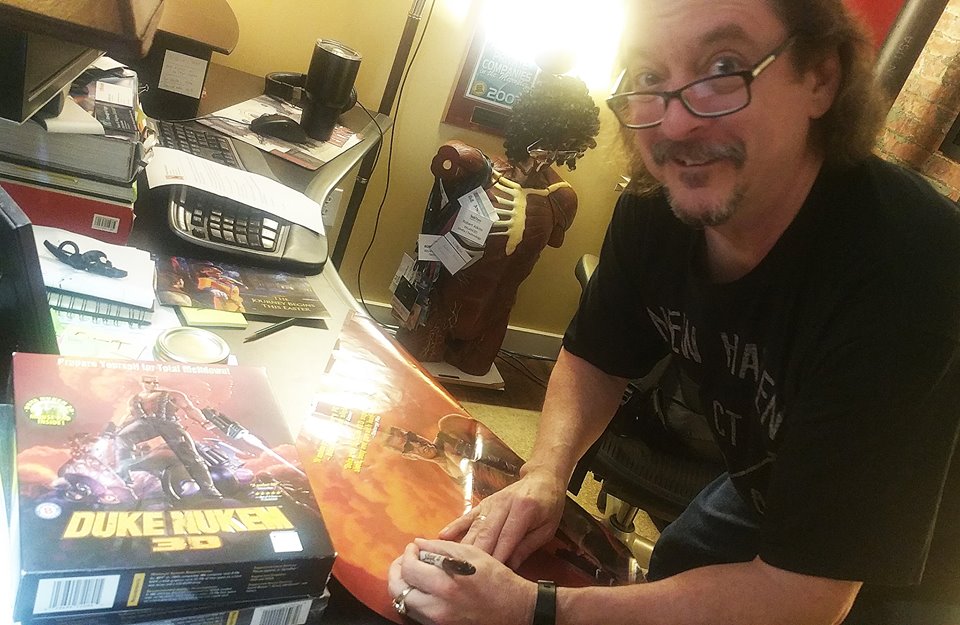
You must have been asked a thousand times how it all began. But since we have a narrow theme “The history of the design of the levels of Duke Nukem”, we ask what was the first design idea of the first level of the first game?
It is difficult to remember the very first. Most of the time, I get a lot of ideas when I start any level. At first it is difficult to choose only one and focus on it. It was probably when I came to 3D Realms to work on Duke Nukem. As I recall, the team focused on the levels of outer space (science fiction). I tried to make the base level of the moon both from the inside and the outside. It did not work out very well and never reached the final game.
I love science fiction, but this is not my favorite theme when creating levels. For me, one of the most important aspects of a level is realism and detail. I want the players to feel that they are really in the environment. In science fiction it is more complicated than in ordinary real places. I always think about what Hans Gruber said in Die Hard: “I always liked to make models when I was a boy. Accuracy, attention to every conceivable detail. " I quickly began to do some levels at home, in Los Angeles - I can not remember which ones. But these first levels were probably never used, like the first few levels of outer space. However, if I had to choose, I would say it was a level like LA Rumble or Hotel Hell.
Games today have an incredibly detailed and realistic environment. When we did Duke Nukem, it was not so easy to do. Minimum system requirements: DOS 5.0, Intel 486 with a clock frequency of 66 MHz, 8 MB of RAM, 48 MB hard drive and VGA video card! I can not even imagine such a world now! Maintaining a decent frame rate was our biggest dragon to fight with.
Can you show our readers some of your sketches of past years?
“You cannot inspire creativity; creativity inspires you. ” Levelord, circa 1999 :)
I think we all experience it - when you try to think of something, but nothing happens. Hours or days go by, and then what you have been looking for just pops into your head. Sometimes it even happens during sleep. I make many sketches and notes about ideas that can be used on a level. When I do a level, it's all the time in my head. Instead of trying to push ideas out of my mind, I set them up as a trap, and then wait patiently to grab the next idea that appears. Often these are the best ideas that come from nowhere.
I say all this because it is directly related to the creation of sketches and the recording of things. Advice to novice level designers: I strongly recommend to always carry with you a small notebook and a pencil, even at night near the bed. Get ready to write down your ideas as soon as they come. Do not wait, because often they disappear like clouds of smoke, especially those that come in a dream! Instead of the phone, I use paper and a pencil, because most of what I write down is related to drawings, not just text. Unfortunately, for this interview I don’t have many of these sketches and notes with me. They are hidden among the pieces of paper and stored in boxes. All this is far from me at the moment. I have several digital scans from the first full-fledged AAA game Ritual Entertainment SiN. I will share them with you.

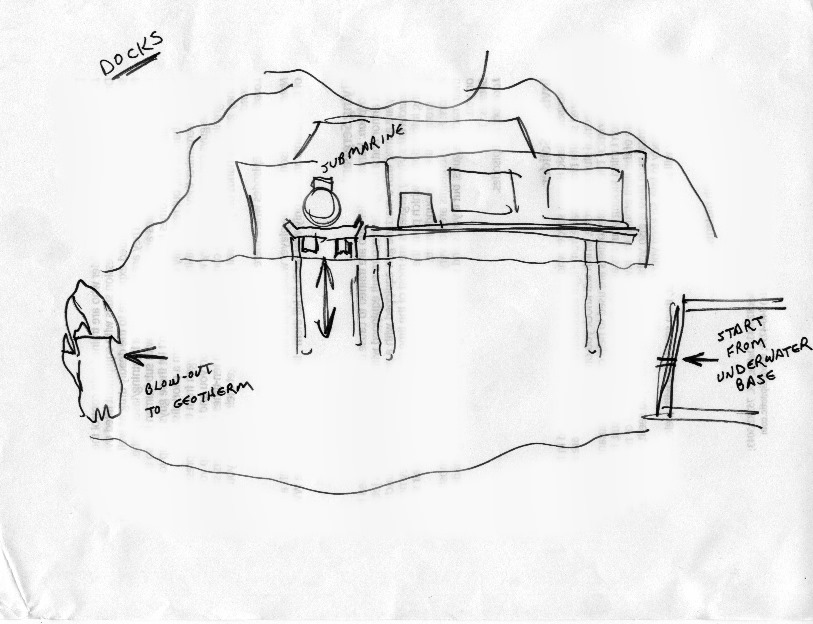
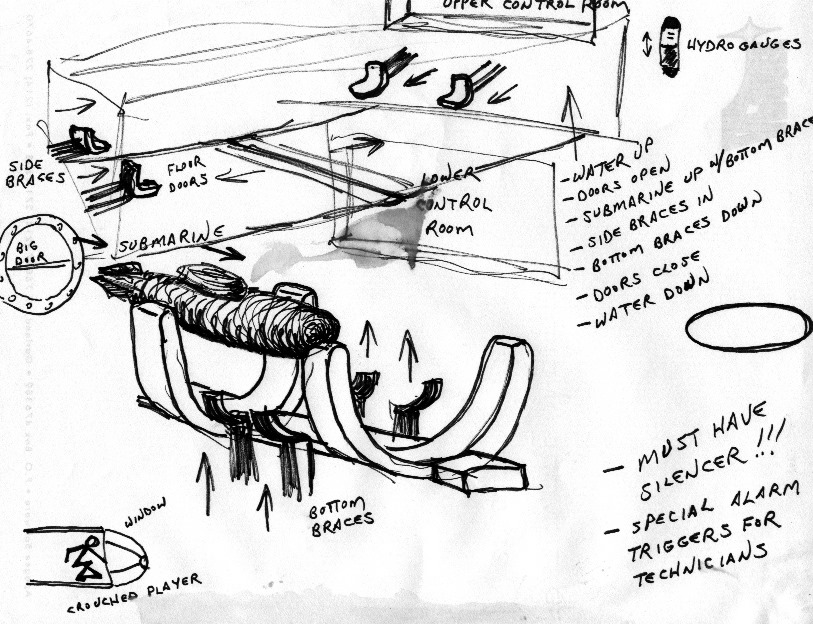
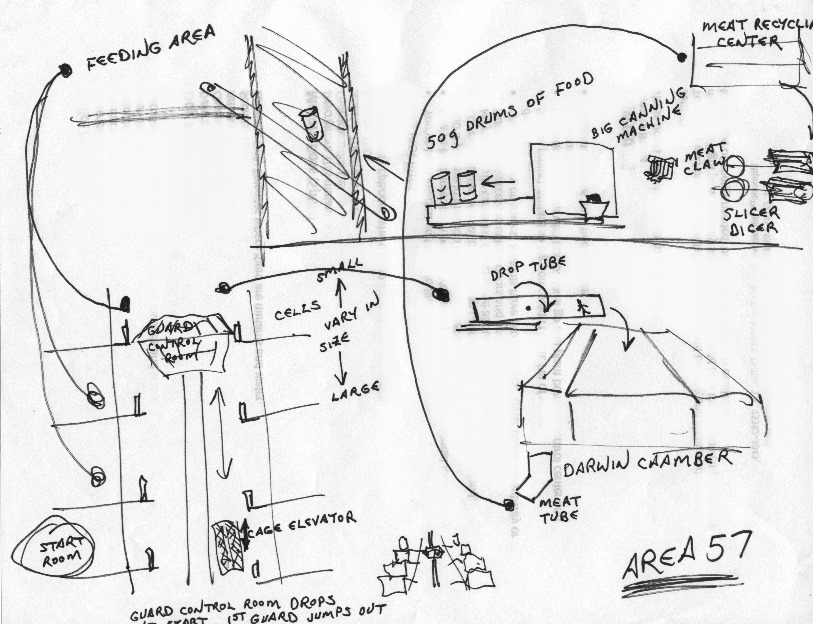
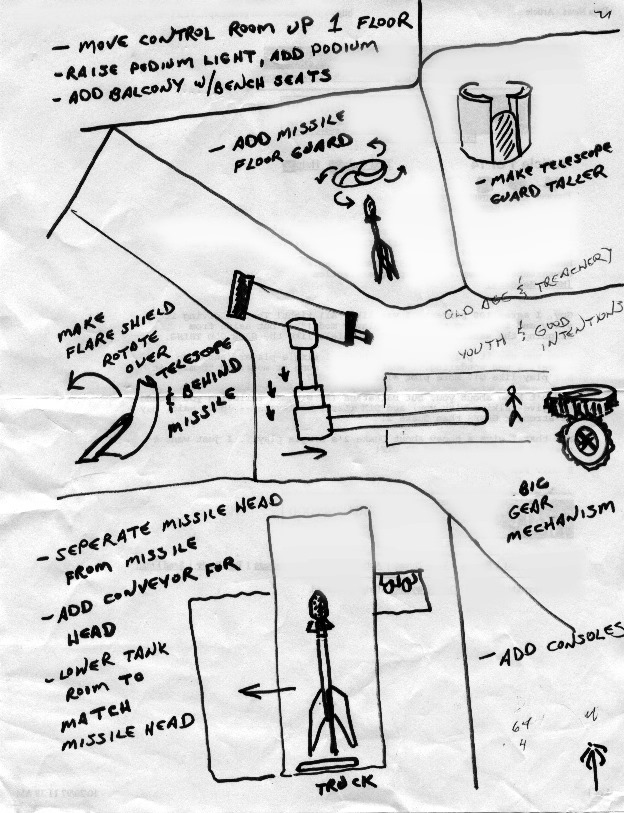
Hidden messages and Easter eggs - your ideas or were they already written in the level scripts not by you?
As I recall, all the Easter eggs that Allen and I put into the game were our own ideas. We invented what we wanted and put them where we wanted. That was in 1996. In 2016, everything changed a bit. We still add Easter eggs and hidden messages to the game, but we are closely monitoring the quality. We have to document everything, where they were and what they "mean", each Easter egg should be recorded with a screenshot. Such monitoring is needed to make sure that we do not initiate litigations and force rating groups, such as the ESRB, to change our rating.

Who thinks up the gameplay levels?
In the original Duke Nukem 3D, Allen and I made most of the original design of the gameplay. In a kind of bottom-up design paradigm, we were very free to create levels and limited only to those that remained within the main themes: space and Los Angeles. I would say that we were game designers when we added each new level. I usually did most of my initial design at a new level of the house, alone. Then I brought it to the office to get approval and feedback. After we had a playable level, the whole team tested it and made suggestions. We did it every day before we went home. So in the end, it was a group work. The whole team developed the game, and it was an incredibly talented team. Greg Malone, producer, and George Broussard, executive producer, tested the levels the most! They spent a lot of time testing the game.
After Duke Nukem, everything changed. The teams grew in size, committees and level managers were created, weekly meetings, official testers, QA ... everything changed. , - / , , . Duke, Fun Factor.
?
. (, . .) . , . . . , — . , .
Wrap it up, Levelord, …enough already!
Okay, ! , . , . World Tour . , ! , . , , .
RUVDS! . , , , Facebook Levelord .
RUVDS , Retro Tech Squot Legacy Z Duke-con — 22- Duke Nukem 3D. - !
1 . — , - Duke Nukem , GearX2 Levelord . . , .
Source: https://habr.com/ru/post/454112/
All Articles